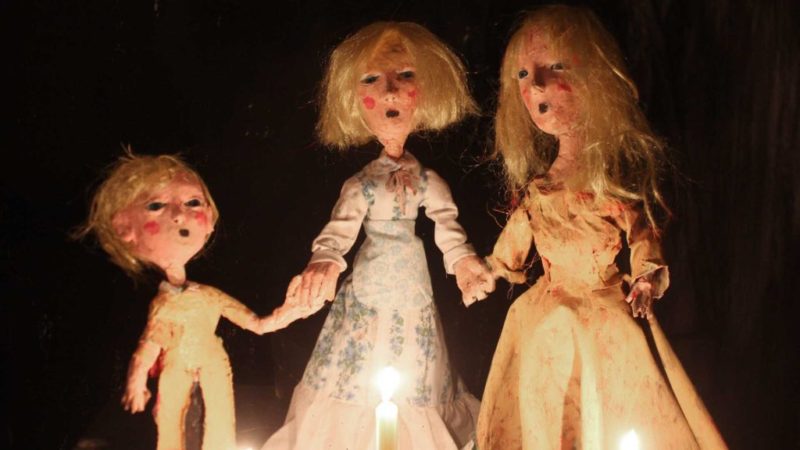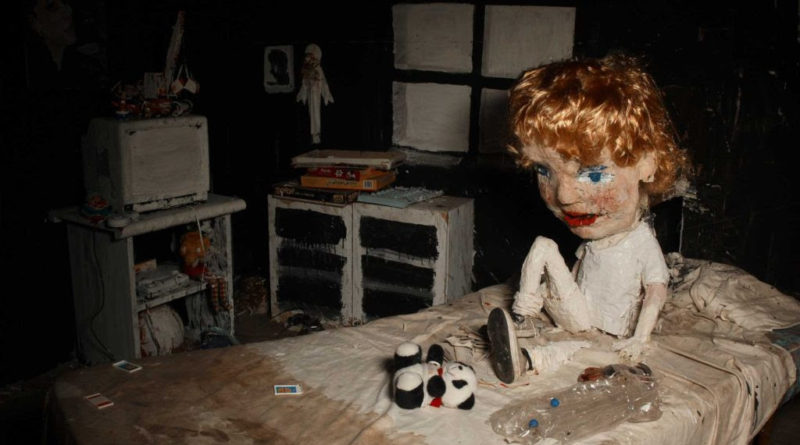INTERVIEW: Animated film ‘Wolf House’ depicts horrors under Pinochet regime
Photo: The Wolf House tells the story of a young woman who flees a group of religious fanatics and finds herself in a tucked-away house facing the nightmares of the past. Photo courtesy of Kim Stim / Provided with permission.
The Wolf House, a new film by Cristóbal León and Joaquín Cociña, is a combination of two cinematic elements that don’t often go side by side: an animation style that tells a dark, dark story — this one, about the horrors of the Augusto Pinochet regime and a religious community in Chile.
“Based loosely on the grim case of Colonia Dignidad, a German émigré-run colony in post-WWII Chile that was revealed to have been used to imprison, torture and murder dissidents during the Pinochet regime, The Wolf House is an animated feature film with a much darker foundation than most,” according to an official press release from Cinema Tropical, which champions films from Central and South America.
The movie, which premiered at the Berlin Film Festival, was originally slated for release in U.S. theaters in March, but the coronavirus pandemic delayed its release. It will now be released virtually Friday, May 15.
The fairytale of a movie, the first feature-length for León and Cociña, tells the story of Maria, a young woman who has recently escaped from Colonia Dignidad. She seeks shelter in a house with two farm animals, but soon enough her nightmares reemerge — this time in a more supernatural way.
The 73-minute feature is a labor of love from León and Cociña, who worked for years and in many different countries to see their vision come to life, according to press notes. The two filmmakers relied on their shared cultural and personal history, both having grown up in Chile. They have been working together since 2007, and, although this is their first feature-length, the directorial duo have had their short films and work exhibited at festivals and museums for a number of years.
Recently Hollywood Soapbox exchanged emails with León and Cociña about the new animated film. Questions and answers have been slightly edited for style.
How closely does the movie follow the real story of Colonia Dignidad?
Cociña: The movie is an animation film structured as a fairytale, where you have human-animal transformations and a house that changes as a nightmare. So, to be honest, it is not really a documentary, but it is inspired [by] the case of Colonia Dignidad, especially in the escapes of some ‘colonist.’ One person that works today in human rights violations in Colonia Dignidad said to me that she was amazed on how similar the opresion feeling of the film was with the narrations of the survivors of Dignidad.
León: It does not follow the story of the colony at all. We imagine the film as a by-product of the colony, a work of art produced in the very specific cultural context of the sect. We played a role-playing game in which we imagined being filmmakers inside the community. We imagined that this movie was directed by Paul Schaefer himself, the leader of the colony. Therefore, none of the horrors of the colony is explicit in the film.
When did you first hear of Colonia’s story?
Cociña: This is not a secret in Chile. Colonia Dignidad was all over the media when Paul Schäfer was caught in Argentina (2005). Actually the first news about the violations of human rights were public already in the ’60s. But the sect had (have?) a strong protection network in politicians, neighbors, the Catholic Church and so on. There is also a strange behavior in Chile about this kind of terrible cases: I have the theory that in our country memory works as sand, or more specifically as water on sand. You cannot say that there is no memory, but it drains and disappears fast. So in a way our work is to keep the water flowing.
León: The story of Colonia Dignidad is a very present story in our country. The colony played a central role in the recent history of Chile. This makes them different from other isolated and eccentric communities like the Amish or Menonites. Colonia Dignidad was several things: a sect led by a semi-divine figure; a criminal organization that committed every conceivable crime (from tax evasion to pedophilia, through trafficking and weapons manufacturing); an intelligence agency that collaborated with the intelligence organizations of the Pinochet dictatorship; and finally a concentration camp for political prisoners also during the dictatorship. They disguised themselves as a welfare and social organization, and this was the image that we had of the colony as children who grew up in dictatorship. They even had a restaurant on the highway where I had lunch with my parents a couple of times on the way to vacation.

How difficult was it to achieve the stop-motion animation?
Cociña: We try to prove that [it] is actually simple. For me, [it] is a matter of focus and time. Of course, it seems difficult to spend more than five years on a single project, but for us [it] was actually a pleasant process. We try to show through the film that if you want to [do] animated or do any kind of art [it] is only a matter of focus. The film tells Maria’s story but also the material’s story. And in this journey we try hard to present the bones and flesh of the process so you can think, ‘maybe I can do the same; it does not look impossible.’
León: We had a lot of practice from all the short films we made previously. We try to keep it simple, and we try to turn our technical limitations into aesthetic qualities. We had a great time animating. Now that I haven’t animated much in the past two years, I miss it.
How long was the production of the film?
Cociña: It was a little more than five years from first shot to the last shot. Post-production was made in two steps: first during the five years production process, working slowly in sound (Claudio Vargas) and other issues. Second, we had an intense and short post-production process on the edge of the world premiere in Berlinale. It was stressful and fun. La Casa Lobo was made as a painter or sculptor’s studio work: 1 to 3 persons working slowly, step by step, in the studio. Some coffee, music and talking while the film was growing, but this is only about the scale of work. Actually, we made 12 open studio shows in Santiago, Buenos Aires, Amsterdam, México City and Hamburg. We build up studios where we spend from 1 to 3 months working on the animation in this open studios-performance places.
León: As Joaquin says, we made a series of exhibitions in museums and galleries, in which we set up our workshop and produced the film in front of the public. This made the process slower, but it was also a great school for us as visual artists.
How did you achieve the ‘single-shot’ feel to the film?
Cociña: We realize quite soon that it was actually a simple trick. To connect one space and other we just framed something that we could take with us or to imitate easily. So, for example, we frame a painting hanging on a wall. We cut the scene, move to another place and start again framing the same painting, but there were some even more simple tricks, like printing the last frame and then destroying the paper on camera. But, of course, there are more complicated ones like taking a head’s puppet into a plane to restart the production in another country. Basically the human brain and eye accepts all [these] silly changes as part of the flow of the film.
This is your feature-length debut. Was it very different than doing a short film?
Cociña: Well, we tried not to think this film was different from our animated short films. In a way our goal was to try to make a feature film as we work in short films. A couple of filmmaker friends told us that it was a really bad idea because it was a technique and visual flow that would not work as a feature. So, in a way La Casa Lobo was made to prove them wrong, but, of course, some things changed. We invited people to work with us in production, art, writing, post-production and sound design. All of them changed the project in their own way. Normally we work without much help. In any case not more than 10 persons are the soul of the project. There is also the issue that for the first time we thought about the audience: it is not the same to be in an art show or theater and see three or five minutes of images and sounds that to sit for more than one hour to see something. So when we realize that we will be inviting people to a dream of more than one … we kind of assume that responsibility. An important part of our work was to keep La Casa Lobo not that far from the audience.
León: Well, I think the work on the script was quite different. In a three- or four-minute short film you can do whatever you want with the story, but it is different when you want someone to sit for more than an hour. The word entertain comes from ‘to hold,’ and that is what we had to do with the viewer. I would have been disappointed if a significant part of the audience had left the theater. I haven’t seen it happen. We tried hard to put together a consistent and enjoyable story, and that’s something we had never tried before.
What do you hope audience members take away after watching this film? What do you hope they learn or consider?
Cociña: Well, I guess that is a difficult question. I believe that no artist is the owner of the meaning of his work. We are not even the owners of the most basic parts of interpretation around our pieces. This is especially difficult for us because to make the film we imagined that we were part of the colony, and this film called La Casa Lobo was actually an animated production from Colonia Dignidad. So we do not agree with anything from the film! But, of course, this is a game. I will love that people take with them the film. I do not know what people will think, but I am pretty sure that [it] is not a film that you will forget that easily. It kind of gets stuck to you, even if you do not want to.
As I said, I will love that some people will feel that they can do whatever is in their minds and hearts. We try to create something that shows you all bones, fibers and blood. So you can make your own animal.
By John Soltes / Publisher / John@HollywoodSoapbox.com
The Wolf House, directed by Cristóbal León and Joaquín Cociña, will be released virtually Friday, May 15. Click here for more information.

